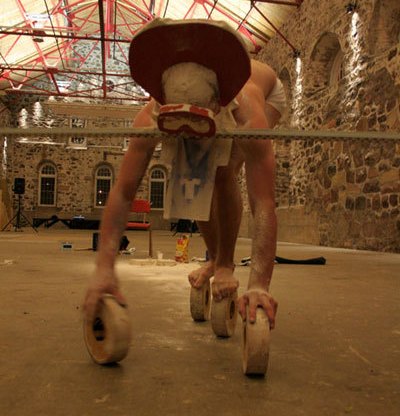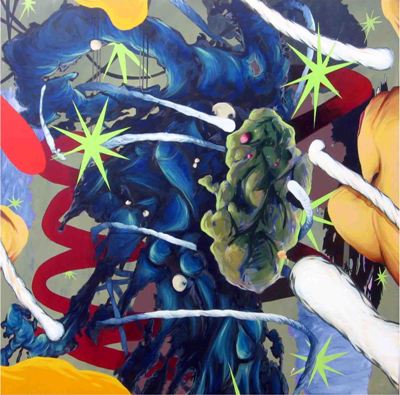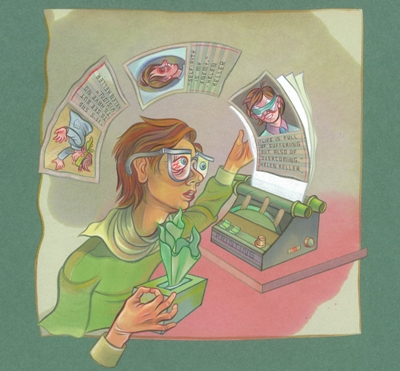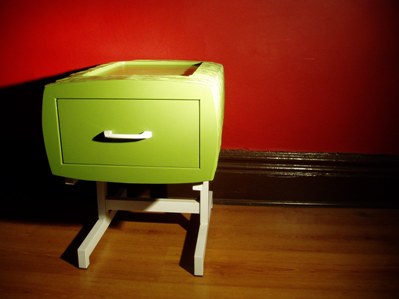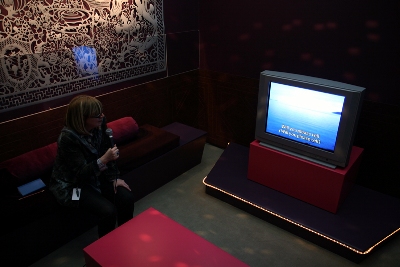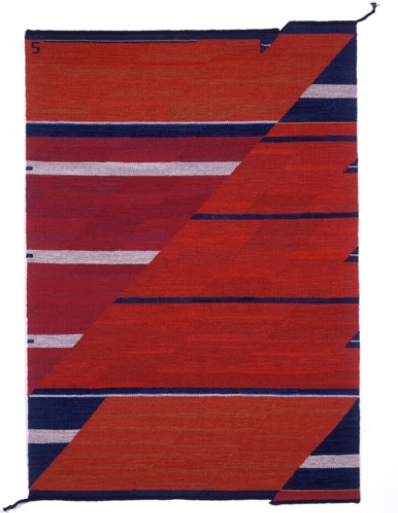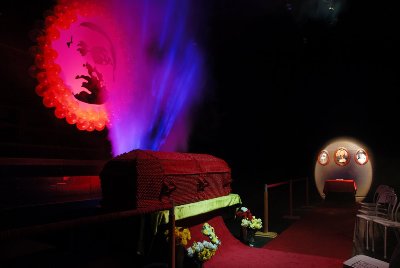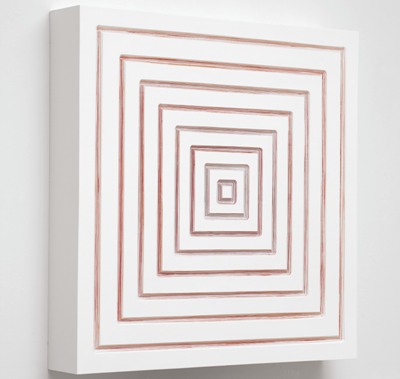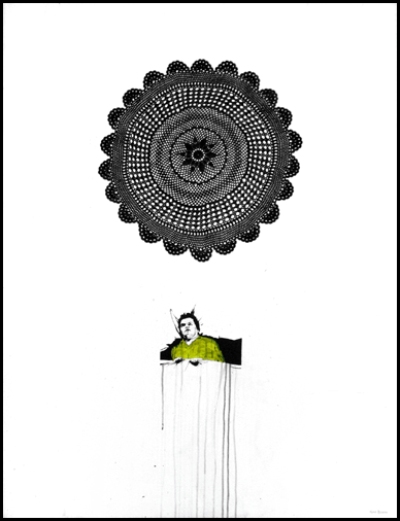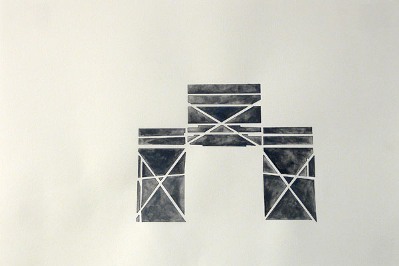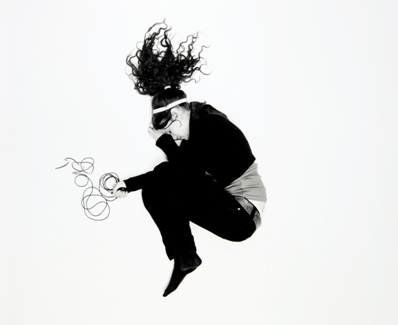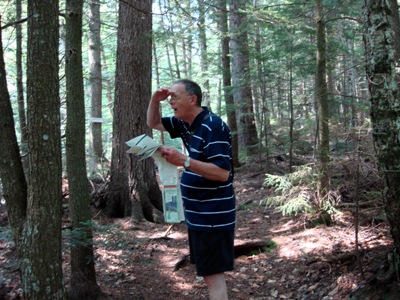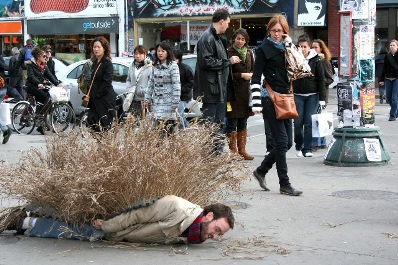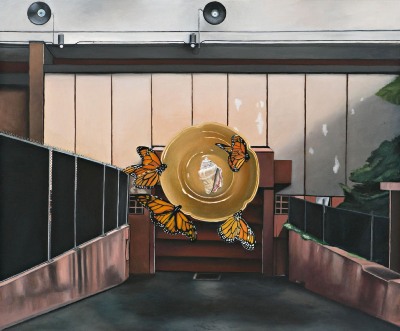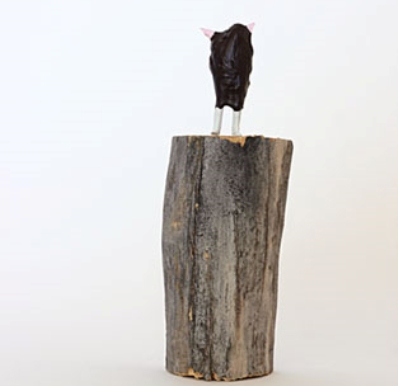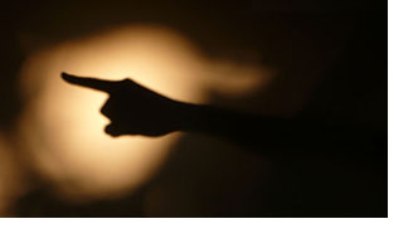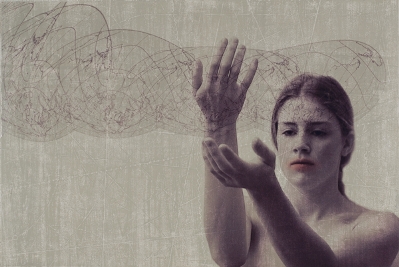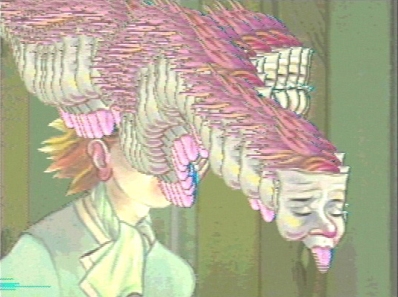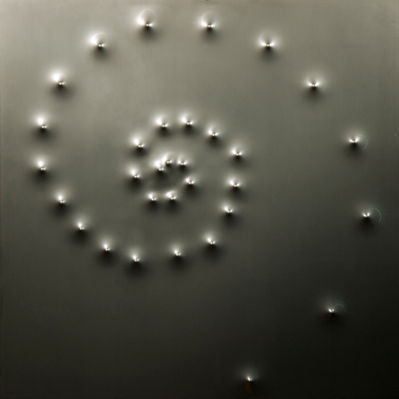Things of Desire Issue #10
October 23, 2008
Greetings Bloglings! The temperature may be dropping outdoors but here at ToD we bring the hottest shows to keep you toastier than your toes inside one of grandma’s extra-itchy wool socks. Also I have to give mad props to Halifax for holding, by all accounts, a killer Nocturne last week. Don’t forget to subscribe, if you haven’t already, by shooting an email to thingsofdesire@gmail.com. Snuggle in and enjoy!
-Mike Landry
Disco Sec
October 23, 2008
By Mike Landry
Invite Montreal-based multidisciplinary artist and writer Christof Migone to a party, and it’s a safe bet he’ll spend his time scoping out your books and record collections. It’s something he says is “a lot less daunting than talking to somebody,” and can tell you just as much about the person.
The phenomena is the subject of his latest exhibition Disco Sec. The show features six different works which draw from the artist’s record collection for material, and tying them together is one disco ball with its mirrors stripped off in a pile below the black orb.
“It bypasses those iconic images and associations we have with the word portraiture and reinvigorates the word,” says Migone. “Bypassing the psychology of a person ultimately gets you back to that. It becomes just as personal and intimate to know how many records a person has and what those records are than if they were to sing you a song.”
Bee Kingdom
October 23, 2008
By Mike Landry
Ryan Marsh Fairweather, Phillip Bandura and Tim Belliveau haven’t yet come to blows or fallen apart like many communal households. For the past four years, like good worker bees, the three young men have relied on good communication and dedication to make things work in their Calgary studio/home. And from Berlin to Tacoma, Washington people are talking notice.
Living and working communally, the trio of young glass artists started Bee Kingdom two years ago. Their studio was their kingdom, and the molten glass in their garage was their flowing honey.
“What’s worked is we all have a common understanding and a similar goal to where we want our glasswork to go. We all want this to work so we work together to make it happen,” says Fairweather.
Orientalism and Ephemera
October 23, 2008
By Stacey Ho
Jamelie Hassan has been in conversation with Edward Said for quite sometime. Said’s pivotal 1979 publication, Orientalism, examined and challenged inscribed Western notions of the exotic Far East. Thirty years later, though the standard is to claim an acceptance of all cultures, this East/West binary remains. One particularly relevant example in North America is how the Middle East still figures as a foreboding singular body, full of religious fanatics, terrorists.
“A lot of the stereotypes are operating in the present tense,” says Hassan. “They allow us to invade their countries and destroy every aspect of their culture. If we look at the history of Afghanistan, one needs to revisit [Orientalism], actually read the book and become familiar with the text from different vantage points and different bodies of knowledge. This has filtered in so many ways into our social context.”
However, despite Orientalism‘s wide social scope, Hassan’s relationship to the text is personal, having read the book early on. The exhibition Orientalism and Ephemera is an idiosyncratic acknowledgment of Said’s influence on Hassan’s thinking, one that expands and contracts according to the exhibition space and the developing dialog between artists, viewers and Hassan herself.
Body Break with Francis Arguin
October 23, 2008
By Mike Landry
This week Quebec City-based multidisciplinary artist Francis Arguin is opening two shows in two different cities, Rouyn-Noranda and Toronto, and in two different mediums, performance and sculpture. And whether he’s pouring sand over himself in his skivvies or installing large cardboard structures covered in crumpled paper his motivation is always the same: exploring the world of objects we surround ourselves with everyday.
It’s not uncommon for Arguin to work simultaneously with performance and in sculpture. He started performing during an installation while he was an art student. He wanted to do something special for the opening, so he made objects that were tools to be manipulated to transform the gallery space.
“My body becomes the territory of the action,” says Arguin. “Everything around us is disappearing. The only thing that exists for me is my body.”
Making Of
October 23, 2008
By Mike Landry
A series of ass paintings, a large mound of papier-mâché, and a homage to Jackson Pollack in the form of a studying desk littered with gum on it’s underside—just three of Mathieu Lefevre‘s small sculpture works from his latest exhibition Making Of.
Each piece is made from a new process Lefevre has been toying with—making art by not trying to make art. Grouping his creations together the show becomes a statement about finding more meaningful and productive ways to waste time.
“Just sitting around thinking about stuff, twiddling thumbs, waiting for inspiration to hit—you’re not really making anything but you are at the same time,” says Lefevre. “So all the pieces are made through just sitting around thinking about other stuff besides what you’re doing, which in this case was making pieces for this show.”
COM POSE
October 23, 2008
By Mike Landry
During the last five years of his life, Saskatoon-based artist Ellen Moffat‘s dad suffered from dementia. His language deteriorated beyond the point of common understanding. However, Moffat found she was able to communicate on a different level. It struck a chord, and she realized how restricted we are using words to communicate.
Moffat’s idea of what she assumed to be language changed. She began to notice how the amount of media we’re inundated with daily removes meaning from the information. The cacophony blurs notions of left and right, and point of views become more like data than language.
Her coming exhibition, COM POSE, takes this shift in language as its subject. In one piece language is broken down to its vocal sound components (called phonemes), and in another text becomes a toy.
Surfacing
October 23, 2008
By Mike Landry
After making a name for himself with his video work, Collin Zipp is taking breaking a break. He had been editing something on his computer a few months ago and was getting a nasty headache. So he went out to his garage, picked some old wood and started building
The result ended up being his first non-video exhibition, Surfacing. For the exhibition, Zipp has compiled the products of the all ideas that had been popping into his head recently. Surfacing will include sculpture, painting and collage.
“I’m kind of making a leap away from my comfortable area, and jumping into some new work,” says Zipp. “I’m pretty pumped about it.”
Hollow cores, other findings and one last chance
October 23, 2008
By Stacey Ho
A brief list of some of the items in Jerry Ropson’s upcoming exhibition, Hollow cores, other findings and one last chance: drawings, framed and unframed; drawings done on glass with vinyl; “There” prints depicting wooden shacks, smoke, piles, and other personal symbols of his native Newfoundland; black on black “Here” prints, featuring lists, himself and another character in the process of various tasks; axes that double as metre sticks; bottles; ice with messages frozen inside, molded into bottles; flags with scraps of love letters left in sidewalk cracks; tubes with secret messages written inside them; ladders; a worktable covered with pseudo-scientific notes and experiments.
“It’s funny,” says Ropson. “I had all these notions of what it’s about. There’s so much going on, anyone coming in and responding to the work will take away different things.”
This open-ended practice appeals to Ropson, as it draws others into his personal process, with an emphasis on chance encounters and happenings. Within the gallery, viewers are meant to tamper and interact with the space. Within the city of Montreal, flags, ice bottles and other tokens will be left around personal sites of significance. Ropson’s list-writing gives another glimpse of the small, fleeting things that make up his thoughts and life.
Proverbs for Paranoids
October 23, 2008
By Mike Landry
Rather than spending his lunch hours Tupperware dining, Pete Smith would go exploring with his digital camera. He was living in Toronto at the time and was documenting the physical geography around his home and his work—graffiti, billboards, paint spills and what he calls “visual interferences in our visual landscape.”
“Our landscape is pretty much filled with junk—graphic junk that we don’t really notice or pay attention to because there’s just so much or it and it’s all competing,” says Smith.
His latest series of abstract paintings take these visual interferences, and reworks them in an act of escapism from this busy world. The works are part of a new exhibition called Proverbs for Paranoids. Sometimes he takes recognizable forms like the city of Toronto, or the recycling, logo, but mostly he takes images hidden in the background of advertisements and logos.
House of Voltage
October 23, 2008
By Mike Landry
Beginning just four years ago short term electronic workshops at Halifax’s Centre For Art Tapes begot long-term master’s classes. Those in turn got the wheels turning and director Ilan Sandler cobbled funding together to establish a pilot electronics program at the media centre. Now, set to begin its second Electronics Residency Program, the pilot program has become part of the centre’s core operations. Such was the demand for electronic arts in Halifax.
“CFAT has been around for 30 years and has looked on the horizon for the development of artwork. And as a media centre it’s not a huge stretch of the imagination to set up an electronics lab.”
The fruits of the first electronic residency will be on display at Halifax’s Eyelevel Gallery for the exhibition House of Voltage. Featuring the work of five primarily visual artists, the pieces combine programmable microprocessors, electronic circuits, and sensors applied to audio, video, and new media applications with their own artistic practices.
Madonnas
October 23, 2008
By Mike Landry
Looking at her secondhand washing machine fills Quebec City-based artist Diane Landry with appreciation for the convenience. Not only because for 12 years she schlepped her clothes to her local Laundromat, but because she can remember hovering around the machines all the time during her childhood.
The washing machine in her piece Stolen Waters isn’t all that different from her mother’s or the one quietly sitting in her home. The only difference is the mirrored cylinder sitting on the machines spinner reflecting an image of a woman. Landry has a few of the machines now, each with a different image of a woman.
“I try to keep [my objects] mostly the same without transforming them. By not modifying them you recognize the object but it doesn’t work the way you used to see it. But it’s still a washing machine. It’s possible after the exhibition for the washing machine to be a washing machine again.”
Surface Dwellers
October 23, 2008
By Mike Landry
Eight years ago Ross Bonfanti, fresh out of art college, stepped into the world with a fine arts diploma in hand and only pennies in his pockets. He wanted to find a job that could pay the bills and related to art so he could continue to grow as an artist. That’s when he landed a job in the faux finishing industry.
“It was kind of exciting to work with faux finishing, because they were doing a lot of commercial gigs. You’d be going into places building scaffolding and learning different finishes,” says Bonfanti. “I did it to gain experience, experiment with new material and also make a little bit of money.”
Bonfanti’s story isn’t uncommon in the art community. And for his coming exhibition at Toronto’s AWOL Gallery he’s brought together some artists he met during his tenure as a faux finisher. The show will highlight each artist using a larger work along with a couple of small “samples,” which are used in the faux business by designers and clients to show their ideas.
Things of Desire Issue #9
October 16, 2008
A tip of the hat to you lovely ToD readers! Looks like we arts lovers will have to band together more than ever after Tuesday’s election results, and there’s no better place than here to know how active the Canadian visual arts scene is. So sign up to subscribe, if you haven’t already, by shooting an email to thingsofdesire@gmail.com. Also, if you’d like to write for ToD we are now looking for one or two more writers who are willing to work for free and blogzine glory. If you know anyone, or would like to lend a hand yourself, please just send an email. Enjoy!
—Mike Landry
I Have Never Felt Sexually Attracted to Anyone At All
October 16, 2008
By Mike Landry
Winnipegger Daniel Barrow‘s stories begin, simply enough, with a visual image. But, when that first idea is so odd it’s not long before he ends up with a film featuring a garbage man creating a phone book with personalized portraits and who is being stalked by a serial killer.
Such was the plot in his now finished and much acclaimed work, Every Time I See Your Picture I Cry. His latest work in progress is no different. I Have Never Felt Sexually Attracted to Anyone At All started with the image of someone reverse waxing themselves.
“I just had the image of a very slim nubile hairless body lathered with Vaseline grabbing a cat blanket from the backseat of a car and then burnishing their body and peeling it back to reveal hair,” says Barrow. “And I just developed this idea that this could be a way someone could commit suicide if they were allergic to cats.”
The F Word
October 16, 2008
By Stacey Ho
The sixties and seventies saw the rise of two major trends in North American art. With the rise of second-wave feminism, mostly white, middle-class women began to explore issues of gender and power, seeking agency from predetermined social and economic roles. Concurrently, this era saw the rise of video technology, so that, for the first time, moving pictures could be produced and distributed cheaply, outside of commercial television channels and large studios.
The F Word, at Vancouver’s Western Front, brings together these two trajectories, looking at women who used video to explore gender, performance and develop a critical methodology. The show includes contemporary as well as historic pieces, such as Lisa Steele‘s 1977 The Ballad of Dan Peebles.
“It’s Lisa when she’s younger,” explains Candice Hopkins, curator at Western Front. “She’s holding this picture of her grandfather, almost like she’s channeling him in a way, in a frantic or sensitive way. She channels memories of him and speaks in a monologue for sixteen or seventeen minutes about this man. You get a sense of a bit of a troubling relationship, of abuse and loss. An incredible performance.”
Life on Marrs
October 16, 2008
Furniture was always a very parental concern to me. It was something I was to keep my feet off of, my dirty fingers away from and not to be poked with a fork. I never really understood how being a grown up suddenly made furniture fun. Then again, my parents never owned anything like the genius that comes from Graeme Marrs‘ shop.
For three years Marrs has been running his own company creating contemporary craft furniture. His work is driven by a strong sense of creating things by hand, which need to be created by hand. He uses old and obscure techniques that cannot be easily replicated en masse.
“The biggest reason for me doing things by hand is that there’s a certain element you can’t mass-produce,” says Marrs. “I’ve always felt imparting time into an object adds a non-tangible element to it. When someone touches something I’ve spent hundreds of hours on they get that back in some way.”
Temporary Architectures
October 16, 2008
By Mike Landry
Photographer Susan Dobson used to live in the suburbs. She was a commuter and lived by her car. Now, living in downtown Guelph, she’s come to reject that way of life.
As a result, much of her work has dealt with the suburban landscape and environments. Her latest series of photographic works take box stores as its subject, with Dobson digitally blackening the buildings to create a dark box. In particular, it was the Sears building in downtown Guelph that drew her to the project.
“It’s just a box, a very long elongated strip. And it almost becomes a barrier between sky and parking lot,” says Dobson. “I found that was an example of the most banal architecture I had ever seen.”
Empty Orchestra
October 16, 2008
By Mike Landry
Maiko Tanaka’s earliest memories of karaoke involve late nights, laughter and adults acting shockingly un-adult-like. Tanaka and her brother, unable to sleep from the noise, would sneak to the stairs and watch the scene below through the banisters wondering what was going on.
Her parents had immigrated to Canada from Japan, and had brought their love of karaoke along with them. Young Tanaka was introduced to the strange Japanese country-sounding songs by other Japanese immigrants crooning in her living room. Her new exhibition Empty Orchestra, which she co-curated with Toronto Reel Asian International Film Festival art director Heather Keung, examines the impact of karaoke from her home to her neighbourhood, across generations and borders.
“I’ve been doing [karaoke] since high school—probably 300 times. I can’t get enough of it. It’s really the most fun communal activity you can do with your friends,” says Tanaka. “I also love shameful pop music.”
Making Real
October 16, 2008
By Mike Landry
Eli Bornowsky isn’t sure if the next week is going to be fortuitous or bad, but he sure is stressed out. The Vancouver artist is presenting 10 new abstract works at Blanket Contemporary Art Inc, as well as opening a show he curated at Or Gallery.
Both shows deal with the artist’s conviction towards a particular kind of subjective experience. It’s an experience he feels abstraction does quite well.
“It has to do with thinking about your sensing, thinking about your thinking, and experiencing your experience,” says Bornowsky. “It’s also a difficult experience, which I find challenging. And that challenge is important for looking at art.”
The Maybe People
October 16, 2008
By Mike Landry
Drawing inspiration from children’s books and folk tales, Vancouver-based painter Jude Griebel has become a modern day Geppetto turning material into people’s portraits. Griebel crafts implied bodies of his subjects using domestic objects from his subject’s lives, such as scraps of clothes, furniture and other domestic material.
Griebel has been working figuratively in his work for the past five years dealing with themes of alienation, isolation and the imagination. His latest work has him making the whole piece figurative, turning his subjects into scarecrow like forms.
“By using pieces of these people’s personal symbols and arranging them it often stands in for them without the flesh,” says Griebel. “It’s these traces of these people, and it could almost be them. Often it seems more real, and carries more information about them, than an actual conventional painted portrait.”
Danish Modern
October 16, 2008
By Mike Landry
Danish-born textile artist Suzanne Swannie‘s life has been a negotiation between degrees of strict economy and wild adventure. After earning a Danish hand weavers Journeyman’s certificate and a degree in Textile Design and Technology from Sweden in the early 60s she crossed the Atlantic for a two-year teaching position in Newfoundland. This balance of adventure and Danish modern economy would end up shaping her life and work.
“My production has been very interrelated so all the rest of my life,” says Swannie. “There were a lot of shifts and changes in my life, and each era in a way produced a certain type of work that fit into my state of mind and situation.”
Wooed by the Canadian landscape, Swannie stayed in Canada getting married, divorcing and raising two daughters on her own. The following decades were spent busily trying to balance her life with thread being her second language.
Biographies: Un regard contemporain sur l’Acadie
October 16, 2008
By Mike Landry
Jennifer Bélanger likes to think of herself as an adopted Acadian. Although she was born in Edmundston her parents were both from Ontario. With a last name like Bélanger it’s not hard for her to pass for l’Acadie.
But it could be that her own personal mixed notion of identity is playing a role in a new exhibition she’s co-curating with full-on Acadian Mario Doucette called Biographies: Un regard contemporain sur l’Acadie. The show brings together eight contemporary Acadian artists who deal directly or indirectly with notions of identity. It’s a theme that may be influenced, but Bélanger says isn’t limited to, Acadian heritage.
“I tend to look at these artists in a broader way. To see what they’re doing within the whole spectrum of contemporary art. The fact they’re Acadian, I suppose, it’s secondary for me. But that might be because I’m not really Acadian.”
Empty
October 16, 2008
By Mike Landry
Joined under the banner of the exhibition Empty at Montreal’s Galerie Push, Kotama Bouabane and Jamie Campbell present two takes on the theme in their hip photographic work.
For his half of the show Boubane presents selections from two series of work. In Chalkboards, Boubane documents chalkboards at the Ontario College of Art and Design over the span of a week. He found it spoke to the outmoded nature of photographic technology, in that everyday newer cameras effectively erase older ones. He also liked how language could be transferred to text and then erased.
“Photography in general is the idea of capturing something, but it’s just an image on a two dimensional surface you can never really capture it wholly,” says Bouabane.
Things of Desire Issue #8
October 9, 2008
Top of the day ToD friends! I would like to give a grand chin-grabbing nod of artful appreciation to the more than 100 subscribers reading this week. Thank so much for jumping on board the ToD art boat. Here’s hoping there’s smooth sailing ahead. And for those who have yet to sign up to ToD, if you like what you see help us get up to 200 subscribers and email thingsofdesire@gmail.com. Enjoy!
-Mike Landry
Jeremy Hof: Painting with Power Tools
October 9, 2008
By Mike Landry
Before Jeremy Hof knew anything about art he knew he was a painter. Now his passion for the medium has taken him to forefront of emerging Canadian visual artists, after taking home top prize at this year’s RBC Painting Competition.
It’s an interesting to position to find young Hof in given his work could be argued as having as many sculptural elements as painterly aspects. And it’s a claim Hof agrees with, but insists that doesn’t mean he works aren’t paintings.
“I want to see painting evolve as well into areas maybe that aren’t familiar,” says Hof. “I want to try and create alternatives for paintings that will spawn new ideas or different understanding of what a painting can be. I personally don’t believe a painting just has to be paint applied with a brush on a piece of canvas.”
They Are Making Art
October 9, 2008
By Mike Landry
In the song “East Coast West Coast” Mary-Anne McTrowe describes herself as “an East Coast artist. I like systematic stuff, but I’ve never rally made anything because the ideas are good enough.” Her band mate, Daniel Wong, then chimes in, “I’m a West Coast artist. I’m a touchy feely guy. I like to watch all the birds and clouds as they float across the sky.”
A true art band, The Cedar Tavern Singers AKA The Phonoréalistes is the brainchild of art history buffs McTrowe and Wong. Under the guise of a folk duo, the pair aim to free art history from its no-fun, stiff-collared academic existence.
“Our attitude towards it is more like those obsessed fans who draw pictures of their rock idols and know every detail about them,” says Wong. “It just happens that our rock idols are people like John Baldessari and Yves Klein.”
Reading Machine for Dr. NO
October 9, 2008
By Stacey Ho
In a textual piece from the early eighties, Vancouver artist Rodney Graham rewrites a scene from Ian Fleming’s Dr. No. Part of an extensive body of work that reconfigures the classic super-spy, lenz loops a climatic scene where Bond is caught in a fix—a centipede crawling up the length of his body. In Fleming’s version, 007 shakes off the bug and smoothly saves the day. In Graham’s version, the centipede is always there; Bond never escapes.
A take off of Graham’s practice, Derek Liddington’s Reading Machine for Dr. NO similarly loops a car chase scene from Dr. No. In Liddington’s piece, the bad guy’s car never flies off a cliff, does not blow up. Rather, James Bond is forever being chased in an infinite figure eight. There’s no pay off.
Liddington’s play on Rodney Graham’s strategies extends upon his fascination with Vancouver’s art scene, where artists, mixing their work with pop culture and academia, would freely appropriate each other’s practices.
“It’s a very traditional approach, much like the idea of an apprenticeship,” says Liddington. “Building a practice based on the practice of others is a traditionalist process that I’m interested in.”
Fear the Doily
October 9, 2008
By Mike Landry
When Alain Bonder was living in Montreal his dad used to send him random images with notes scrawled on the bottom. One of his favourites was an image from an old Italian horror movie of a man cowering under the covers.
For many years the note lived stuck to the Ottawa-based painter’s walls. But something clicked last year, and Bonder decided to pair his own macabre rendering of the image in black and monster green with an ornate doily dipped heavily in black paint. Although it was meant to be a keeper, Bonder soon found himself with an entire series called Fear the Doily.
“On top the doily looks dead on like a UFO to me. So it was this strange object, but at the same it’s something that would never hurt you,” says Bonder. “You would have to really try to be hurt by a doily.”
The Task at Hand
October 9, 2008
By Mike Landry
When I was 15-years-old my uncle Noel hired me to help him with some roofing one cool winter’s day. Although the rough and heavy shingles were nightmare inducing, there was nothing I hated more than having to unload, build, move and take down the scaffolding. To this day whenever I look at scaffolding I scowl and shiver.
But when Vancouver-based artist Matthew Robertson looks at scaffolding he sees art. Using pieces of wood reclaimed from construction sites, Robertson has built his own scaffolding inside Vancouver’s Jeffrey Boone Gallery. His exhibition, The Task at Hand, will also feature drawings and large format photographs dealing with scaffolding.
“I like that they’re these large publicly visible structures that are esthetically unconsidered when it comes to designing, and are nice impermanent structures,” says Robertson. “I’ve been studying them, in my own way, trying to decipher why these seemingly bizarre structures to me why and how they function.”
High on a Hill
October 9, 2008
By Stacey Ho
Sometimes love is just not meant to be.
Trapped on two separate snowy mountains, a pair of alpine lovers in green attire yodel to one another above a howling wind. As their calls intensify, the storm subsides and the snow melts away. Heidi and her goatherd lover fade into their freshly green mountain backdrop. The sound of trickling water is all that remains.
This short video is the centre of High on a Hill, a new installation by Lisa Lipton. Playing off The Sound of Music-style kitsch, the exhibition asks viewers to participate in the gallery space. Surrounded by towering green mountain murals, Lipton adds a touristy plywood mountain vignette to the gallery. Visitors step behind the sculpture to have their photo taken as Heidi or the goatherd.
Retelling Anne
October 9, 2008
By Mike Landry
To celebrate the 100th anniversary of Anne of Green Gables the University of Guelph’s Macdonald Stewart Arts Centre has created a contemporary response to Anne. Retelling Anne brings together the work of six female emerging artists working in a variety of media that feature Anne of Green Gables as their launching point. However, the works are a far cry from literal representations of either Anne or Lucy Maud Montgomery.
“Lucy Maud was a pioneer, not just as a writer but as a female writer,” says curator Dawn Owen. “That kind of creativity and independence she obtained 100 years ago as a published writer really paved the way for a lot of the creativity from women today. So, it was really important to cement the idea of the continuing evolution of creative practice”
Instead of literally retelling the story of Anne, the show looks at bits and pieces from the books that resonate in the artists’ contemporary work. None of the artists have ever met each other, or been exhibited together. The exhibition is meant to really challenge the work, because of the context in which it’s being shown, and create a new community of voices.
Abstractions of a Paradigm
October 9, 2008
By Mike Landry
Living in Honokaa, Hawaii Scott Yoell is surrounded by beauty. The former Windsor, Ontario research-based artist moved from Montreal to Hawaii with his wife who was originally from the islands. But even in his little paradise there’s a certain menace under all its beauty.
“Things are great,” says Yoell. “But you can’t help but look down when you’re walking on a beach and see this pile of plastic pouring out of the carcass of a baby albatross. You can’t help but be affected by that, or at least I can’t.”
Yoell’s latest series, Abstractions of a Paradigm, takes the idea of manufactured paradises as its subject. Billed as “fantastical responses to a conflicted world,” Yoell examines the darker side of humanity’s attempt to create unnatural worlds—be it television, excellence in sport or the effects of colonialism.
Michael Pittman Shrinks Heads
October 9, 2008
By Mike Landry
For an artist driven by psychological experiences, like Newfoundlander Michael Pittman, nothing can provide more fodder than a near death experience. While out cutting wood recently he was pouring gasoline too close to a fire and there was an explosion. He could have been badly injured, but he received only minor injuries. It was more the shock of the experience that he struggled to deal with.
Pittman, who describes his dreamy paintings as “quasi-diarist investigations into perception,” was influenced to create a series of works centred around the weeks before and after his near death experience. The pieces are meditations on both mortality and vitality.
“It was something I would never have considered a life changing event that sort of turned out to be and made me consider a whole lot of other things,” says Pittman. “When I speak about this accident, I compared the way that I reacted to past experience of others in instances of similar events or things that have come together in my research.”
Jennifer Zimmer: self-portraits
October 9, 2008
Throughout grade school I don’t think I had a single usable portrait taken of me. Year after year I would come home with a selection of photos that went from bad to worse. It was all thanks to what my mom called my fake smile—a goofy expression that only occurred when I was placed in front of a camera. If only Halifax photographer Jennifer Zimmer was my class photographer.
Zimmer’s latest series of 18 hand-made photographs play with the ideas of portraiture. She had her subjects lay down in the fetal position and use a shutter release cable to take a photo when they felt most comfortable.
“It’s kind of a sense of individuality, isolation and a bit of vulnerability in each one,” says Zimmer. “The point I wanted to make was in a limited environment, even though constraints are put on us, our individual bodies still seek expression.”
Things of Desire Issue #7
October 2, 2008
Ahoy-hoy ToD readers! I hope you’ve had lots of rest, because we have a whirlwind issue this week that is sure to leave you jetlagged. This week we’re proud to bring you coverage from Dawson City, Yukon’s Valerie Salez. If you like what you see send us some love by becoming a subscriber and email thingsofdesire@gmail.com. Enjoy!
—Mike Landry
Radical Drag
October 2, 2008
By Stacey Ho
Considering the current federal cuts targeted at art production, it does well to be reminded that what is precious in art is often what fearful conservatives are seeking to eliminate.
Radical Drag, opening at Ottawa’s SAW Gallery, presents performance, photography, wearable artworks, sculpture and video: art that uses drag to align issues of sex and gender with other forms of dispossession. The exhibition looks at examples of this practice as a form of social critique, addressing ideas of race, war, colonialism, and trauma.
“The state would impose legislature on what a body looks like, how a body is to move,” says Tobaron Waxman, who co-curated the exhibition with Stefan St-Laurent. “Drag has always been a vanguard in terms of being in conflict with that.”
Rouyn-Noranda Presents…Rock Opera!
October 2, 2008
By Mike Landry
There are niches, and then there is Montreal-based interdisciplinary artist Céline B. La Terreur. If anyone were to write the best Quebecois rock opera, it would be her.
So when Stefan St-Laurent, curator of the 4th Biennale of Performing Art of Rouyn-Noranda, asked her if she would like to participate in this year’s biennale’s theme of rock opera she jumped on the chance. With an interest in visual arts and the leader of an electronic alternative rock band she was both flattered and a little surprised to be invited.
“I was surprised rock opera was even known outside of Quebec and France, because I think it’s a very francophone thing,” says Terrreur. “I didn’t even think that kind of tacky project would be heard of outside of Quebec.”
Days of our Lives
October 2, 2008
By Mike Landry
Given TV Guide’s nod as the greatest television program of all time Seinfeld revolutionized television with a show about nothing. The characters were free to live their lives episode to episode, often facing mundane situations inspired by Larry David’s daily life.
I’m not sure if New Brunswick-based artist/curator, and Coordinator of Sackville’s Struts Gallery, John Murchie is a fan of the series, but for his latest curatorial project Days of Our Lives brings the genius of the show to Calgary’s Nickle Arts Museum. Working for two weeks in the gallery space, and the museum’s collection of almost 5,000 works, Murchie will assemble an exhibition on the fly.
“The basic premise is there must be other ways to present art works to people in public galleries than the way we normally do,” says Murchie. “This project is hoping to reflect reality better than most exhibitions do, in the sense that most of our lives aren’t driven by some thesis or end view. It’s more as things go along we respond to what happens.”
Valerie Salez: Noah of the North
October 2, 2008
By Mike Landry
In the midst of a morphine induced stupor Dawson City-based artist Valerie Salez asked her boyfriend to write down three sentences—“The cat’s outta the bag; the dog’s outta the box; and the rabbit’s outta the hat.”
The cryptic statements described her visions of animals streaming forward, from smallest to biggest, through a vast white expanse. Salez was given the morphine after she had an appendix attack during an artist residency in Southern Yukon. Although she had to have her appendix removed the experience inspired her latest exhibition, Congregation.
“After the morphine and vision it was during recovery back at the residency that I just began to sit and cut every cat, rabbit and dog from every book I had. I did this for weeks and it felt completely liberating and right.”
Penance and Devotion
October 2, 2008
By Mike Landry
One fifth of a kilometer never seemed so long for Toronto artist Gareth Bate as it did last November. Crawling on his belly from Soho Street to Spadina Avenue with a mat of field grass on his back, Bate spent two hours worming with his face an inch from the sidewalk.
But it wasn’t the crawling forward that forced him to stop—it was crawling backwards to Soho Street.
“Making Penance was such a surprise it was neat to explore some totally different thing than what I had done before,” says Bate. “You realize you’re not one thing. There’s this whole other aspect.”
Memories of Montreal
October 2, 2008
By Mike Landry
Toronto-based painter David Holden can’t remember what caused him to head home to Montreal a few years ago. But since then he has been returning again and again with his latest series of paintings.
His newest series of paintings incorporate childhood landmarks from the Montreal neighbourhood he grew up in along with symbolic images from his past and current life.
“The buildings and locations are almost like the backdrop, a stage set. I end up dropping in these other images and creating a narrative that way,” says Holden. “It layers my personal history from when I was a teenager and more relevant things that are happening to me now.”
Halifax goes Nocturnal
October 2, 2008
By Mike Landry
In the small town of Deep River, Ontario bears are a common nuisance. Every fall they wander in town and can be spotted in trees and in school playgrounds. For most residents the bears are a dangerous inconvenience, but for Halifax-based sculptor Heather Keeling they were an inspiration.
“Like many Canadian I guess I’ve had a lot of personal experiences with animals—especially bears and deer. They’ve crept up into my life many times before,” says Keeling. “Those moments when you do come in contact with wildlife are special, and they’ve caused me to pursue wildlife images.”
For her coming exhibition at Halifax’s Seeds Gallery, Keeling will be showcasing her ceramic nocturnal animals. The works were created during a year-long residency in Lunenburg.
Stitch by Numbers
October 2, 2008
By Mike Landry
A few years ago Carmella Karijo Rother didn’t call herself an artist. She would go to museums and look at abstract art, but she wouldn’t “get it.” Then she discovered Mark Rothko.
“I thought I had died and gone to heaven. It was just the right thing I came across at the right time. I fell in love with his paintings,” says mixed media textile artist Karijo Rother. “The feeling I get looking at [Rothko] is the kind of feeling I’d like people to have when they look at my work.”
Working with curved shapes cut from silk, Karijo Rother uses an undulating parallel stitching to cover her pieces. She mixes the movement of the stitching with colours to create a movement and energy. She’s called the abstract series Numbers because she didn’t want to suggest what her pieces are about.
Demonstration and Rational Demons
October 2, 2008
By Mike Landry
Google searching the definition of demonstration doesn’t turn up anything particularly interesting. You’ve most likely used the word hundreds of times and thought nothing of it. But Canadian born Norway-based sculptor/installation artist Andrew Taggart can’t help but see something sinister in the word.
His newest exhibition Demonstration and Rational Demons features various soft and hard sculptures of “demons, owls, walruses, and whoever else shows up” around a fire.
“The work evolved from an investigation into the concept of “demonstration,” and how the words “demon” and “monster” hover within the word itself,” says Taggart. “Showing art can be seen a demonstrative process, I am interested in the rituals and behaviours that accompany this form of demonstration, be they dark, absurd, sacred, powerful or alienating.”
Votes for Sleepwalkers
October 2, 2008
By Mike Landry
The pieces part of Vancouver’s VIVO Media Arts Centre‘s coming Votes for Sleepwalkers exhibition seem like they were pulled from an futuristic art show as envisioned by a 1950’s sci-fi novelist. There’s spy codes, shifting lights, tiny cinemas and a gallery plinth that can see you. A typewriter that emits music as you type. A motion/light activated wave making machine. An orange chair fitted with a motorized helmet that gives you partial control of the sounds you make. They’re delightfully intriguing as they are impractical.
The experimental creations are the offspring of VIVO’s Studio LAB, which offers workshops and facilitates collaborative projects for electronic media artists and technology enthusiasts.
“It is a kind of a bridging of education production and presentation. It is about experimentation really through the space, peer support, technical assistance, mentorship,” says SLAB programmer and project coordinator is Dinka Pignon. “Some of the artists are established artists while others are emerging, but each of them is pretty new to the technology they are using.”
Things of Desire Issue # 6
September 25, 2008
Sup ToD homies! I hope you all have had the chance to dry-clean your favourite festival-going attire, because this week kicks off the fall festival season. This week we bring you coverage from Edmonton’s print international, Toronto’s ImagineNative film and media art festival, and a selection from Halifax’s Photopolis along with a smattering of non-festival exhibitions from across the country. If you like what you see send us some love by becoming a subscriber and email thingsofdesire@gmail.com. Enjoy!
—Mike Landry
Edmonton Prints
September 25, 2008
By Mike Landry
Last week a crate failed to arrive for installation at the Edmonton Print International 2008. There was some concern given EPI had paid the airfare for the Finnish artist, Annu Vertanen, to install the wall-sized piece. Since the competitive international exhibition is organized by the non-for profit Society of Northern Alberta Print-Artists (SNAP), such a bust would tough.
The crate eventually showed up, and was installed in record time. The scare was just one of many pieces that have fallen into place to make the exhibition a reality. After five years of work, Walter Jule, the general secretary for EPI 2008, says they’re ready to present a show that stands up in international print community.
“Our byline for the show is ‘A Celebration of the Printed Image,'” says Jule. “We just want to show Edmonton this is the breadth of what’s going in contemporary print expression around the world, and ask what do you think.”
Beatrice’s Centre for Student Affairs
September 25, 2008
By Mike Landry
Jennifer Cherniack almost didn’t want to be quoted as saying so, but one day she wants to move back to Winnipeg.
“My most complicated relationship in life is with Winnipeg. There’s something about the city that I can’t get away from,” says Cherniack, assistant curator/public programmes manager with Toronto’s InterAccess Electronoic Media Arts Centre. “People ask me where I’m from I tell them I’m originally from Winnipeg but I live in Toronto. It’s always like I’m a visitor somewhere else.”
Cherniack’s interest for her hometown inspired her to curate Beatrice’s Centre for Student Affairs, or, How I learned that my mother was right about making art in a prairie town during the rise and fall of grunge music. Using works from Winnipeg-born artists Daniel Barrow, Jo-Anne Balcaen and Evan Tapper, Cherniack presents an exhibition about art school, coming of age stories, gossip and forced reunions.
Trauma Sutra
September 25, 2008
By Mike Landry
Taking aim with his father’s .357 in hand Newfoundland artist Raymond Roddick had an epiphany.
He had just returned home from a four month Buddhist retreat where the monks reminded him constantly to focus on his breathing. And here he was out shooting with his dad who was reminding him to pay attention to his breathing. And suddenly things clicked.
“There was a connection between these two things—they both have to do with concentration, focus and stopping in a bunch of different ways. I just jumped in at that point,” says Roddick. “The only idea was to make a mark [with a gunshot] and not penetrate the surface completely to make a very small sculpture.”



